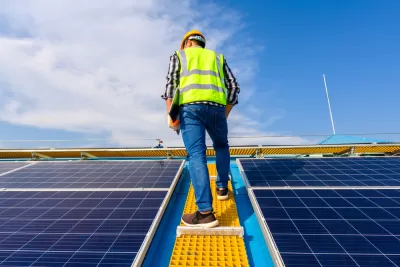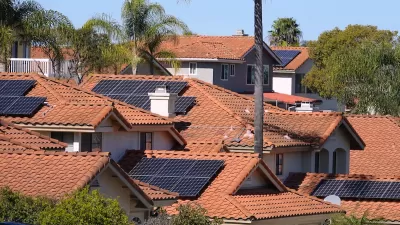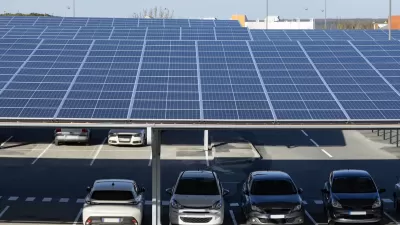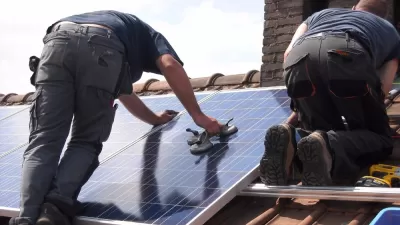Requirements in the NYFD fire code make it costly and difficult to achieve the city’s solar installation goals.

As part of New York City’s plan to reduce emissions by 80 percent by 2050, the city “aims to install 1,000 megawatts of solar technology within the five boroughs by 2030, enough to supply 250,000 homes with electricity.” But so far, “NYC has a 70 megawatt solar gap to close this year alone in order to fulfill its 2030 goal,” reports Zoya Teirstein for Grist, hindered in large part by the city’s building and fire codes.
“[A]s of 2019, the city requires all new buildings and major renovations of existing buildings to include either solar panels or a green roof system. But putting a solar installation on every rooftop in the city isn’t easy — and especially on the rooftops of existing buildings.” At the heart of the conflict is a 2021 revision to the city’s fire code, which calls for “more access pathways around panels and railings around rooftops that have solar on them.” Despite this rule applying to new construction only, the city’s Department of Buildings has denied solar permits for existing buildings on this basis. The rules also designate solar panels as “serviceable equipment” that triggers requirements for walkways and guardrails.
“There’s been no communication with the industry. There’s been no public forum,” says T.R. Ludwig, CEO of Brooklyn Solarworks, citing 13 examples of projects rejected due to the new fire code. While solar companies can apply for variances, the process adds expense and time to the permitting process.
For its part, the city has made some changes to accommodate these concerns. “After conversations with stakeholders,” [Rachel Finkelstein, a senior policy advisor for the NYC Mayor’s Office of Climate and Environmental Justice] said, the Department of Buildings “no longer interprets this section of Code as requiring railings for solar installations. The fire code remains unchanged.”
FULL STORY: NYC wants more rooftop solar. Its fire code is getting in the way.

Planetizen Federal Action Tracker
A weekly monitor of how Trump’s orders and actions are impacting planners and planning in America.

San Francisco's School District Spent $105M To Build Affordable Housing for Teachers — And That's Just the Beginning
SFUSD joins a growing list of school districts using their land holdings to address housing affordability challenges faced by their own employees.

The Tiny, Adorable $7,000 Car Turning Japan Onto EVs
The single seat Mibot charges from a regular plug as quickly as an iPad, and is about half the price of an average EV.

Seattle's Plan for Adopting Driverless Cars
Equity, safety, accessibility and affordability are front of mind as the city prepares for robotaxis and other autonomous vehicles.

As Trump Phases Out FEMA, Is It Time to Flee the Floodplains?
With less federal funding available for disaster relief efforts, the need to relocate at-risk communities is more urgent than ever.

With Protected Lanes, 460% More People Commute by Bike
For those needing more ammo, more data proving what we already knew is here.
Urban Design for Planners 1: Software Tools
This six-course series explores essential urban design concepts using open source software and equips planners with the tools they need to participate fully in the urban design process.
Planning for Universal Design
Learn the tools for implementing Universal Design in planning regulations.
Smith Gee Studio
City of Charlotte
City of Camden Redevelopment Agency
City of Astoria
Transportation Research & Education Center (TREC) at Portland State University
US High Speed Rail Association
City of Camden Redevelopment Agency
Municipality of Princeton (NJ)





























